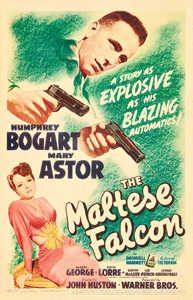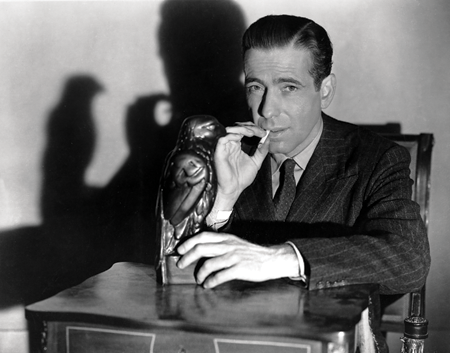
1941

EVERETT
The Maltese Falcon
DIR. JOHN HUSTON

© WARNER BROS., COURTESY PHOTOFEST
A bird in hand is worth . . . well, a lot, given the murders and double-crossings that Humphrey Bogart’s Sam Spade encounters in this early noir.
Sure, Humphrey Bogart’s portrayal of Sam Spade in John Huston’s The Maltese Falcon remains the very model of the modern movie detective, but the role was reportedly first offered to tough-guy actor George Raft. And Bogie wasn’t the first to step into Spade’s gumshoes: Dashiell Hammett’s jazz age novel had been made into a film twice before (in 1931, and in 1936 as, of all things, a comedy starring Bette Davis). But in Huston’s directorial debut, it became the definitive adaptation—and what has been called the first film noir.
Hammett’s reworking of two of his 1925 stories from the pulp magazine Black Mask, The Maltese Falcon begins when a mysterious, beautiful woman who calls herself Miss Wonderly visits Spade. Though she claims she’s looking for her missing sister, it isn’t long before the focus shifts to the search for “a black figure of a bird,” a.k.a. the titular falcon. After multiple murders, double-crosses, fisticuffs, and a drugging . . . well, it’s hard to figure out what the heck the mysterious statue actually has to do with anything. But when it comes to noir, a coherent plot is often strictly for the birds.
Unlike the works of noir’s two other great pulp progenitors, Raymond Chandler and James M. Cain, The Maltese Falcon was (in Huston’s hands, at least) faithfully adapted to the screen. Though the director streamlined the action and (due to the censors) trimmed the sex, he kept much of the dialogue—with one significant exception: The famous line referring to the falcon as “the stuff that dreams are made of” was Huston’s own (well, paraphrasing Shakespeare). It both joined the cinematic lexicon and reflected the theme of failed quests that would come to define many of Huston’s subsequent films.
In addition to kick-starting a lifelong friendship and collaboration between Huston and Bogart, the film featured such marvelous character actors as Sydney Greenstreet; Peter Lorre; and Huston’s father, Walter, in roles that were reportedly inspired by people Hammett met in his own career as a Pinkerton detective. Spade, however, “has no original,” the writer himself once said. “He is a dream man in the sense that he is what most of the private detectives I worked with would like to have been, and, in their cockier moments, thought they approached.”

© WARNER BROS., COURTESY PHOTOFEST
From left to right: An unknown actor with Peter Lorre (Joel Cairo) and Humphrey Bogart (Sam Spade) at the Hotel Belvedere in the film that defined the detective genre.